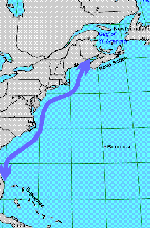 |
 |
 |
 |
 |
 |
 |
Right Whale Migration Update: February 2, 2000
Today's Report Includes:
- Greetings from the Stellwagen Bank!
- The Most Endangered Great Whale
- Why the Right Whale?
- Where Are Right Whales Found?
- Peak Time in the Calving Grounds
- Who's Who? Challenge Question #1
- Winter Feeding Group Returns
- Three Hundred Minus One: Challenge Question #2
Greetings from the Stellwagen Bank
Greetings from the Stellwagen Bank National Marine Sanctuary! I'm Anne Smrcina, the education coordinator of the sanctuary (located off Cape Cod, MA) and your right whale correspondent. Although I'm not a whale researcher, I'll be contacting a variety of scientists, naturalists and government officials over the next few months to give you the latest updates on right whale migrations and the status of the population.
Most Endangered Great Whale
The Northern Right Whale is considered the most critically endangered of the great whales. The North Atlantic population consists of about 300 animals - and its numbers have not been increasing lately. Scientists are very worried that this species may not be able to survive beyond the next 200 years and may go extinct.
Why the Right Whale?
These whales were considered the "right" whale to hunt because:
- they were big (up to 60 feet long and 60 tons)
- they were slow swimmers (often feeding on drifting plankton at the surface)
- they floated when killed (because of their large supplies of blubber) and
- their strands of baleen were long (reaching lengths of 6-7 feet).
Right whales were targeted by whalers in the 1600s through the 1800s. By the start of the 20th century there
were few to be found. In the mid 1930s an international agreement forbid the hunting of right whales but, despite
this protection, their numbers have not grown significantly.
Where Are Right Whales Found?
|
Range of Right Whale |
- the Cape Cod Bay area as a winter/early spring feeding area,
- the Bay of Fundy and other areas off Nova Scotia as summer feeding/breeding grounds,
- an area off the Georgia/Florida coast is the calving grounds (for pregnant females)
Peak Time in the Calving Grounds
Peak abundance of right whales in the calving grounds, as well as calving, occurs from December through March. Because this is the only known calving grounds, the waters are designated as "critical habitat".
Can you find the right whale calving grounds on a map?
The area extends along the shoreline, from the mouth of the Altamaha River in Georgia (31.18 N, -81.20 W), south to Sebastian Inlet, Florida (27.51 N, -80.27 W); and out from the shoreline 15 miles along Georgia and northern Florida, and out five miles from the shoreline along the central Florida coast.
Who's Who?
Right whale researchers have been able to identify all of the whales that regularly come up to the Gulf of Maine (with a significant number coming into Cape Cod Bay and Stellwagen Bank) during the winter and early spring. Here's a challenge question for you.
Challenge Question #1
"How do the researchers tell one whale from another? How do they identify each individual?"
(To respond to this question, please follow
the instructions below.)
Winter Feeding Group Returns
The winter feeding group has started to return to Cape Cod Bay and the Gulf of Maine. Plot these sightings on a map:
1) On January 1, the Coast Guard reported sighting a single right whale off Ram Island on the northeast side of Portland Harbor, near the shipping lanes to Portland, Maine (approx. position 43 39N, 70 14W)
2) On January 7, a fisherman reported sighting 7 right whales including a possible calf east of Nauset Beach, Cape Cod, Massachusetts (approx. position 41 52N, 69 55W).
3) On January 23, an aerial survey with researchers from the Mass. Division of Marine Fisheries and the Center for Coastal Studies reported sighting 3 right whales on the edge of the Stellwagen Bank National Marine Sanctuary (approx. position 42 06N, 70 15W).
4) On January 27, one whale was spotted by the Coast Guard and Mass. Environmental Police off the Wellfleet coast in Cape Cod Bay (41 55N, 70 13W).
Three Hundred Minus One
Along with the good news of the sightings, there has been sad news. A sighting of a dead right whale south of Block Island at position 40 59N, 71 35W. This dead whale has been identified as a three year old female. The cause of death is unknown at this time, but the scientists are hoping to be able to get the carcass ashore where they can do a necropsy. This examination may provide answers as to what happened to the whale. To date, ship strikes and entanglements in fishing gear have been significant dangers to these whales. The loss of any whale hurts the chances for survival of this entire population, but:
Challenge Question #2
"Why is the loss of a female always of great concern?"
(To respond to this question, please follow
the instructions below.)
That's all for this report. This is Anne Smrcina of the Stellwagen Bank
National Marine Sanctuary signing off.
How to Respond to Today's Right Whale Challenge Questions:
Please answer ONLY ONE question in each e-mail message!
1. Address an E-mail message to: jn-challenge-rwhale@learner.org
2. IMPORTANT: In the Subject Line of your message write: Challenge Question #1(or Challenge Question #2)
3. In the body of the EACH message, give your answer to ONE of the questions above.
The Next Right Whale Migration Update will Be Posted on February 16, 2000.
Copyright 2000 Journey North. All Rights Reserved. Please send all questions, comments, and suggestions to our feedback form
 |
 |
 |
 |
 |
 |

